Before Hellblade , things were somewhat quiet at Ninja Theory. We can argue all day about whether or not the action developer’s Devil May Cry remake was any good or not, but the reality is it didn’t light the world on fire at a time when Capcom was expecting it to. Ninja Theory went on to release a mobile game that didn’t make much of an impact and quietly contributed in some capacity to Disney Infinity. (RIP.) Of course, Hellblade: Senua’s Sacrifice has been in development for multiple years, but in terms of public awareness, it was easy at one point to forget Ninja Theory was around. But now, a week or so before Hellblade: Senua’s Sacrifice launches, it’s the talk of the town again.
Hellblade: Senua’s Sacrifice has me intrigued. It’s a return to what put Ninja Theory on the map in the first place. It has the same motivations that brought Heavenly Sword into being, a game that was rough around the edges but much more respectful and ambitious compared to the oddly crass and slapdash Devil May Cry . Hellblade: Senua’s Sacrifice aims high, tackling a theme of mental illness and once again offering a different perspective from the usual action game fare.
Another interesting part of the Hellblade: Senua’s Sacrifice story is Ninja Theory’s goal in terms of business. Games like Heavenly Sword and Enslaved had troubled releases for various reasons and likely came out at the wrong time. The last generation was full of experiments that failed due to the constraints of the recession in the west more than anything else. Games had to be presented as AAA and either hit a home run or disappear. Now, Ninja Theory is trying to bring back the middle ground. By developing and publishing independently, the company aimed to achieve its goals, cut costs, and release at a budget price. This is a gamble meant to show that games can still inhabit that old space in-between AAA and indie.
At the same time, Hellblade: Senua’s Sacrifice is being crafted with AAA guts in mind, meaning it’s a visual powerhouse. Ninja Theory is using in-house motion capture technology it considers a rival to the likes of that used to make Avatar , a film that moved ticket sales based solely on its technical feats. Again, this is due to that space Hellblade: Senua’s Sacrifice is meant to occupy. This is a game that won’t last longer than 8 hours, something that used to be more common. If a game isn’t as focused on content volume, that much more time and effort can be put into making what’s there, the amount of content needed to tell the intended story, look great. The technology is there to make smaller budget games look good; the fat just needs to be trimmed.

Indeed, Hellblade: Senua’s Sacrifice is such a technical marvel, Ninja Theory insists an incredible machine would be needed to make the game run at 4K and 60fps. On the PlayStation 4 Pro, players will be able to choose between a higher than 1080p resolution or 60fps. Not both. Is this a limitation of the PlayStation 4 Pro or is Hellblade: Senua’s Sacrifice just that beefy? For what it’s worth, Ninja Theory wants us to believe the latter.
Even as someone who had serious issues with Ninja Theory’s Devil May Cry , I find myself intrigued by this situation. Hellblade: Senua’s Sacrifice , if successful, could disrupt the industry in a valuable way. Money is flowing back into video games, and that has meant things like more variety in games that are made and brought over from other countries. But design sensibilities have felt a bit stagnant in a lot of ways. Hellblade: Senua’s Sacrifice could be the project that shows publishers not every AAA-type game needs to be a giant open world with more content than any sane person could go through in completion.
